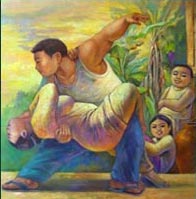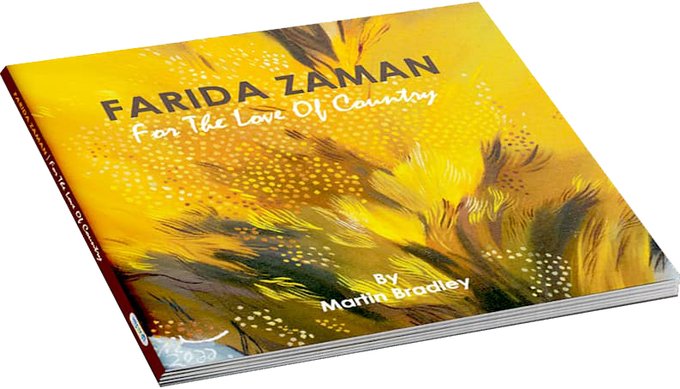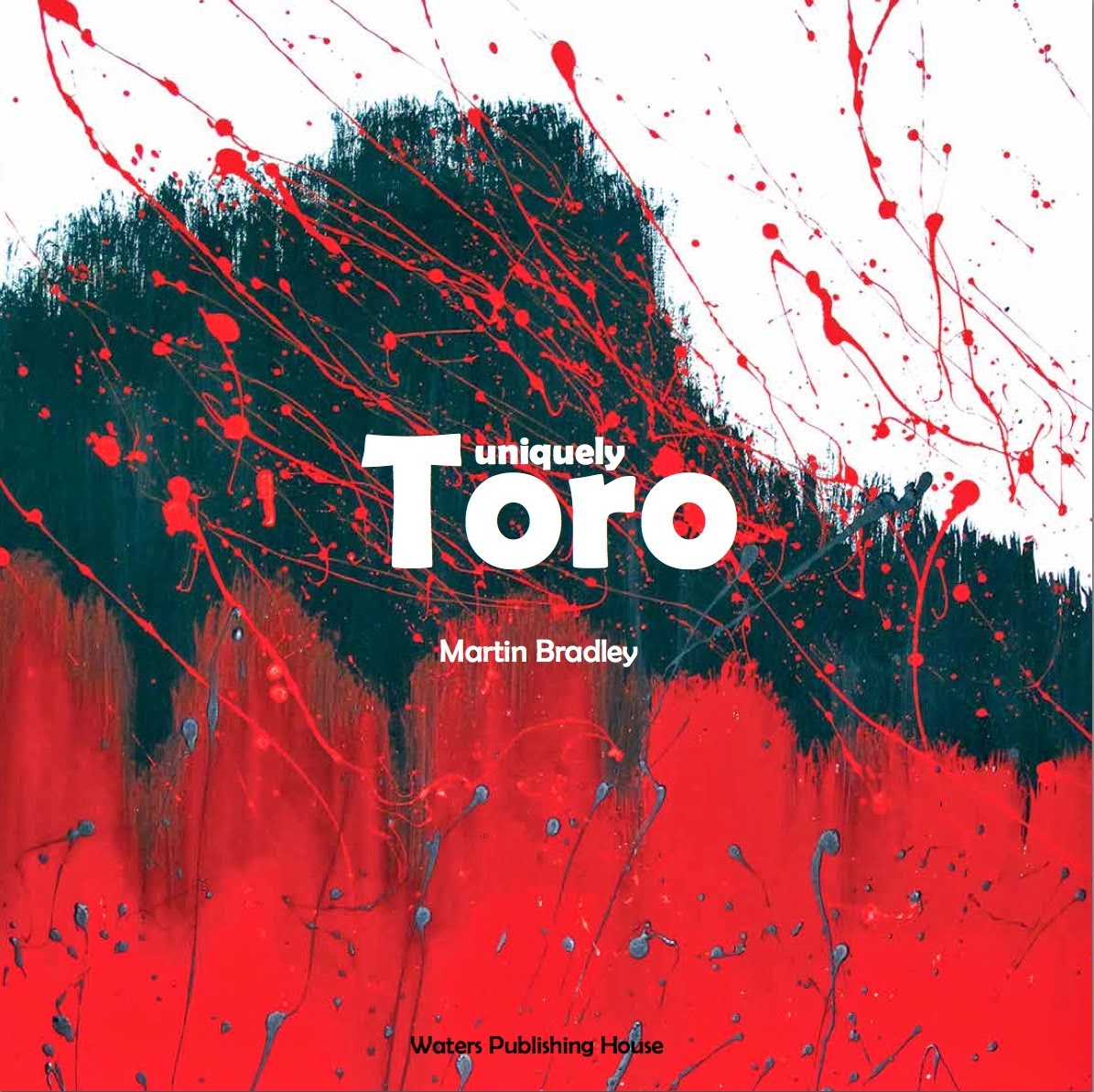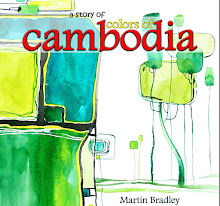
The multi-talented and multi-facetted artist Nizam Ambia is, one could say, an artistic conundrum.
Born Mohd. Nizamuddin Ambia in Seri Menanti (Beautiful resting place) in the Royal state of
Nizam Ambia graduated in Graphic Design from Malaysia’s University Institute of Technology MARA (UITM) and worked for TV3, and, later, for Limkokwing University of Creative Technology. While under the auspices of Limkokwing University Nizam created sculptures, interior designs for the café area and canvases of tremendous organic beauty which still grace the walls and spaces at the university after his departure.
It was Nizam’s recent exodus from Limkokwing, in 2005, which enabled him to metaphorically spread his creative wings and soar, Icarus-like, towards an artistic Helios of radiant success. But, unlike Icarus, Nizam is ever watchful of the dangers of flying too high, and remains at heart a genteel and humble soul; this is clearly evident when you meet the artist in person.
Following his soaring success in
Nizam Ambia is, perhaps, best known for his batik and fashion designs. It is these elements of his work which appear most in the media and public eye, for Nizam has been honoured many times for both his batik work and his contribution to Malaysian fashion. In this brief article my objective is to lay particular emphasis on Nizam’s work other than the much publicised batik and fashion items, intending, perhaps, to bring about a balance.
Throughout all of Nizam’s expressive works there is a strong stylistic theme of the organic and the fantastic, which includes distant echoes of the form and design of Indian kolam, Malay traditional dances and reflections of the intricate Malay Wayang Kulit (Shadow puppets). The overall thread which permeates Nizam’s works, from paintings to batik is that of fluidity. There is a flow of colour, energy and movement all the way through these works which captivates, then envelops the onlooker, taking the viewer by the hand and leading them into an ethereal dimension overseen and narrated by Nizam the storyteller.
Nizam’s visual art strikes not only chords but whole chord progressions of familiarity, calling to mind a host of artists, styles and genres. Reflected in Nizam’s artwork are genteel watercolours such as those of the Edwardian Danish designer/illustrator Kay Rasmus Nielsen. It is not so much an actuality, a mimesis, but a feeling emanating from Nizam’s work, reminding the viewer of the intricacies of Nielsen’s watercolour illustrations - whose own works, in turn, were influenced by Far Eastern artists like Hokusai and Hiroshge.
Nizam Ambia’s two epic cycles of paintings consist of the Sirih Junjung (elaborate and decorative Betel nut ornamentation) and Puteri Kayangan (Fairyland Princess) series. Essentially these are mixed medium pieces combining divers materials including paint and uncooked rice, both culturally and symbolically representative of joyous celebrations, staff of life and promoter of growth/fecundity.
In Nizam’s Sirih Junjung series we, the onlookers, are presented with intricate organic patterns, stunning designs and evocations of celebration, for harmonious joy and salutation accompanies the giving of the sirih junjung - akin to western concepts of ceremonial flower displays and wedding corsages. Dancing, fluid, points of white light evanesce from the painted surface depicting myriad coloured flowers and translucent foliage, radiant, expectant and beguiling.
The organic floral images of Nizam’s Sirih Junjung series radiate with inner beauty achieved with multiple-layers of paint, giving the ethereal nuance of Leonardo Da Vinci’s sfumato effect used to create his La Joconde's (Mona Lisa), or the other worldly evocation of Gustav Klimt’s delicate casein and gold paintings.
It is no accident that many of the works in this series remind the viewer of the Malaysian cultural mixed heritage, with hints and essences of the Indian rice flour (Kolam) designs, for Nizam has engaged in the landscape representation of these too.
Nizam Ambia’s Puteri Kayangan series is the perfect compliment for his Sirih Junjung series, for the Puteri Kayangan series has all the beauty and mystery of the former with the bonus of figurative additions. In the Puteri Kayangan series abstract organics mingle with exquisitely stylistic dancers and Wayang Kulit-like figures, twisting and dancing their way across his canvases, free from constraining rods and shadowy lives to cavort organically and orgiastic-ally.
And dance is what they do - a vibrant, vivid dance of colour, grace and elegance beckoning the viewer to join the mêlée psychically, spiritually, if not physically. For Nizam’s works are not just makan (food) for the eyes, fodder for the orbs, but sustenance for the psyche/spirit, too.
Like the surreal, imaginary works of Chilean painter Roberto Matta (Roberto Sebastian Antonio Matta Echaurren), Nizam’s works reach down into the very soul of the onlooker filling them with mysterious, elusive, enigmatic otherness, and leaving the onlooker with a spiritual sense of nature’s triumph, in Nizam’s uniquely Asian organic symbolism.
Similar to Matta’s works, plasticity and concreteness fuse in Nizam’s paintings creating a space beyond space, where imagination can project itself into, and the onlooker himself become part of, Nizam’s creations. Fronds, petals, hair, jewels all reach out to the viewer, there but not there, as Rene Magritte might say, tantalising in Nizam’s Malay organic multi-medium fantasies.
In more concrete terms the swirling, sensual, organic neo-Art Nouveau lines of Nizam Ambia’s sculptures bring to mind the complex constructions of the British artist and creator of whimsical kinetic sculptures, Rowland Emett. Emett was the darling of the 1951 Festival of Britain, titillating the crowds with his fine kinetic fantasies, and spreading sculptural humour through his wondrously whimsical, yet delicately sound works. Later Emett’s whimsies featured in the film Chitty Chitty Bang Bang, and enlivened Science Centres and Shopping Malls.
Nizam’s three dimensional works have only a passing resemblance to Emett’s, however, for Nizam’s three dimensional works, like the metal neo-Art Nouveau avian colossus which welcomes the visitor to Limkokwing University, appears more heroic than Emett’s sculptures, as if Nizam’s noble thoughts were imbued with solid determination and tangible grace. Nizam’s solidly organic bird sculpture is commandingly spiritual, graceful and elegant, whereas Emett’s works always tip towards humour. Nizam’s majestically symbolic sculpture has the essence of an ethereal phoenix, poignantly reminding the onlooker of the power of learning and the freedom of rebirth inherent in education.
As I started by saying, Nizam Ambia, as an artist is somewhat of a conundrum. Nizam produces stunningly beautiful paintings and a variety of other works too, that is his passion, yet he is able to devote time and energy to prospering the ancient art of batik, and championing increasingly popular fashion attire. Like Picasso, Jean Cocteau, Joan Miro and Salvador Dali before him, Nizam Ambia appears to have the ability to transform the eternally plastic into the stunningly beautiful concrete.
Despite writing briefly here about Nizam Ambia’s visual contribution to art and society, there is, of course, only one way that you the reader will be able to know his work, and that is to seek it out for yourself. If you are fortunate enough to be in
Or you may contact Yayasan Dunia Melayu, who currently represents Nizam and his works, http://www.malayworldfoundation.org/home.htm







